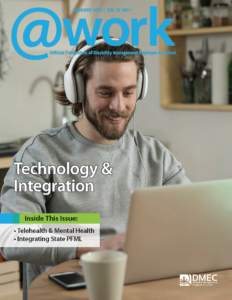
January 2021
Technology & Integration
A recent survey of employers found that COVID-19 accelerated the permanent adoption of digital technologies by several years. From telehealth to video conferencing platforms to claims and accommodation apps, technology is playing a key role in facilitating the significant shifts in how we work and manage leaves. This issue of @Work provides insights and best practices for honing utilization and effectiveness of technology in your organization.
Features
A Beacon of Hope for Americans Struggling with Mental Illness: Telehealth
With telehealth continuing to prove its viability, the question is not “will it grow?” but “which telehealth strategies will produce the greatest payoff for your organization and employees?” Telehealth can help people resolve transient mental health events sooner, move more quickly from diagnosis to treatment, and more successfully manage ongoing mental health conditions. Read more.
Integrating Your Leave and Time Off Programs with State-Mandated PFML
The trend toward new state paid family and medical leave (PFML) laws has grown across the United States in recent years and will continue accelerating. With such rapid and ongoing change, you may be feeling a little lost. The key to compliance when you come up against a PFML law is to apply a four-step decision process for your organization. Read more.

Spotlight Articles
Program Showcase: Remote Ergonomics
Employers may provide ergonomics assessments to remote employees to ensure they have at-home workstations that meet basic ergonomics best practices. These assessments are quite economical, especially when weighed against the duration with which employees may be working from home due to COVID-19 and the savings that could be achieved through injury prevention. Read more.

Program Showcase: "Inactive Status" Leaves
After experiments to identify the best practices contributing to positive outcomes, FPI Management established a new leave category called “inactive status.” Inactive status maintains an employee’s status as employed, but separates the employee from a position. The employee stays in this category until ready to return to work with or without an accommodation, temporarily or permanently, to an open and available position for which they are qualified. Read more.

RTW Showcase: Job Classification Tools
Absence professionals too often must find ways to facilitate RTW efforts with an outdated job description, or nothing at all. When that happens and employers don’t have the ideal of annually updated job descriptions, how do they keep moving forward toward RTW? Federal agencies provide data based on extensive occupational research that can give case managers surprisingly detailed job demands. Read more.

Columns
Absence Matters: Telemedicine
One of the bright spots from the COVID-19 pandemic, and its ensuing challenges, was the interest and acceptance of telemedicine as a healthcare delivery option. The widespread availability of mobile devices and significant technology advancements make telemedicine a viable care option for many patients, with strong potential to improve overall employee experience. Read more.

Integrated Absence Management: Right Care at the Right Time
Healthcare has gone through a revolutionary shift from in-person to virtual care during the COVID-19 crisis. Telehealth can help employers address the worrisome trends of employees delaying preventive medical and dental care and ignoring symptoms, and the increase in pandemic-driven mental health conditions and stress. Read more.

Engaging Today's Workforce: Data Analytics
As companies strive for competitive advantage, information is king. The sheer volume of available data, however, can be overwhelming without the right tools to interpret it in meaningful ways. Data analytics and artificial intelligence are designed to do just that, using historical facts, trends, and predictive modeling to help companies make informed decisions and grow for the future. Read more.

Employer Solutions: Right Support at the Right Time
When an employee is temporarily out of work for a health issue that appears straightforward, there may be unseen factors that could affect a safe return to work. Unseen, that is, by the human eye. Some of the latest claims industry technology is designed to flag commonly missed concerns that may be evident in communications during the claims process. Read more.

Featured Case: Undue Hardship under the ADA
The ADA requires employers to provide a reasonable accommodation to employees with disabilities, unless the employer can demonstrate that the requested accommodation would pose an “undue hardship.” Davis v. Columbus Consolidated Government provides a potential roadmap for an employer confronted with an employee’s request that could pose an undue hardship. Read more.

IAM Technology Tips: Efficient RTW Processes
In recent years, we are seeing fewer nurses managing disability and leave cases. Instead, many carriers, TPAs, and employers have transitioned to a clinical escalation or clinical consultation model in which non-clinical case managers handle the majority of claims and nurses are pulled into only the more complex cases. Read more.

Leave Management By the Numbers: Mining Leave Data
Managing leaves generates a wealth of data, but most leave managers don’t have time to leverage this data to help optimize day-to-day activities and broader workforce strategies. Yet you don’t want to miss this opportunity to use reporting to improve your leave program. Though specific reports may vary between employers, the foundation remains the same. Read more.

Common Sense Compliance: Pandemic Technology Trends
Technology has played a key role as businesses adopt remote operations. Employers are accelerating technology uses to ensure safety in the workplace and enable employees to work productively from home. Employers now are seeking long-term solutions for what they initially anticipated were only short-term needs. Read more.

RTW & Disability: Easing the Way to Retirement
Companies that help employees review Medicare options will find the process mutually beneficial; for the retirement-aged employee, it provides a way to access a wider variety of plans. This in turn reduces employer costs; and when eligible employees switch before retirement, it can reduce the employer’s financial burden of covering those with a statistically higher rate of chronic illness. Read more.

The Disabled Workforce: Employing Technology in Your ADA Process
In many organizations, the rapid spread of COVID-19 has resulted in an increase in accommodation requests. Use technology to ensure you don’t miss steps, continue to interact, and document that interaction. Not just important in a pandemic, you’ll see the benefits of employing technology well beyond COVID-19 and in the “new normal” that follows. Read more.

Departments
The CEO's Desk: Looking Ahead
As we all look ahead, the questions for 2021 are: what is the next normal; what did we learn from 2020; and what can we do better because of the pandemic. Integrated absence management professionals will proudly continue to play a vital role as the nation moves to a blended workforce of onsite and work-from-home employees. Read more.

DMEC News: January 2021
As we enter 2021, DMEC welcomes six new Employer Advisory Council members, two new National sponsors, and two new members to the DMEC Board of Directors. Read more.

Compliance Memos: January 2021
The January 2021 compliance memos cover laws affecting employer COVID-19 vaccination mandates, the coronavirus paid leave tax credit, the DOL's proposed rules for wellness program incentives, and a recent reassignment accommodation court case. Read more.





